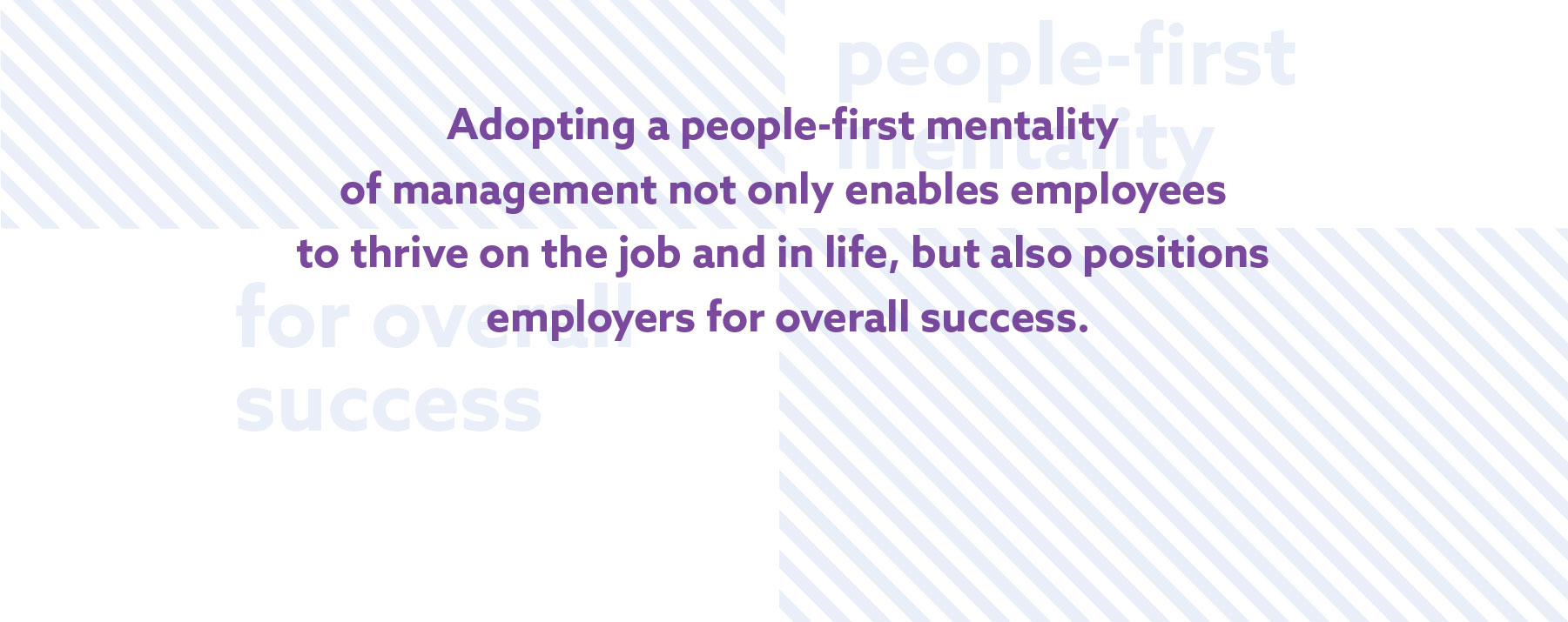CONTRIBUTORS
Mark Debus
clinical manager, behavioral health, Sedgwick
Adam Morell
assistant vice president, product compliance, Sedgwick
Cindy Parker
managing director, casualty, Sedgwick
The last couple of years have seen the rise of significant workplace trends, including flexible work, the Great Resignation and talent war, and increased need for mental health support. All have had a dramatic impact on the role of the employer, reshaping the conversation from what they have to do to support their employees’ health and well-being to what they should be doing. Here, we share trends on how employers are taking on that responsibility in a bigger way and broadening their focus to develop employees — both professionally and personally — to fuel better health and well-being, attract and retain talent, and drive stronger performance.
Normalizing human connection at work
Over the years, there has been a growing effort for employers to support employee mental health and well-being through employee assistance programs (EAPs) and the addition of behavioral health coverage to their benefit plans. However, with 1 in 5 adults experiencing a mental illness each year and work-related stress being reported as people’s No. 1 source of stress in a 2023 report from Calm, employers are now asking themselves: Is this enough?
Pre-pandemic, employees typically assumed responsibility for caring for their own mental health and well-being outside of work. With so many people now working remotely and staying connected 24/7, the line between work life and home life is blurring; this has caused the pendulum to swing away from the resilience model and put more of the onus on employers to take care of their people. In response, employers are enlisting surveys and looking at quantifiable indicators like absenteeism and productivity changes to gauge employee stress levels, but they may be missing a key component: understanding how their employees are really doing.
When everyone works together onsite, it’s easier for managers to recognize the telltale signs of employee distress. With many now remote or on a hybrid schedule, the visible clues are harder to detect and require more deliberate action at the manager level. It’s no longer enough to have a quarterly performance review or conduct an annual engagement survey; leaders need to invest more time in connecting with their teams.
Recommendations for managers
1. The power of check-ins: Managers should schedule weekly meetings (virtually or in person) with their individual team members and listen more than they speak. In addition to discussing work status, managers should make a concerted effort to focus on the employee. Some questions to ask include: What can I do to support you? Is something happening at the office or at home that I can help you address? If an employee brings up something going on in their lives, like an upcoming trip or an illness in the family, make a note of it and remember to inquire about it again at an appropriate time. Managers should also ask themselves: What can I do to help my team members feel cared for and successful?
2. Training and accountability: Normalizing mental health and wellness should start at the highest levels of an organization. Leaders modeling healthy attitudes and openly sharing aspects of their own lives can leave a lasting impression on employees and bring added dimension to their humanity. Some employers are partnering with behavioral health specialists to develop and implement interactive training programs that reshape the perception of the stoic leader into one who leads not only with strength, but also with empathy and vulnerability. We tend to think of empathy as an innate quality, but it’s actually a skill that can be learned and cultivated.
Training programs help leaders approach and communicate openly about their own struggles, which in turn gives employees the freedom to share their emotions and be authentic. Leaders are also being encouraged to model healthy practices like mid-day walks and activity breaks, therapy appointments, and prioritizing time away from work. Beyond training, employers can further normalize these practices by holding managers accountable for healthy behavior as part of their performance reviews.
3. Fostering opportunities for connection: There is power in the collective, and managers are trying various ways — such as working together one day a week at the office and hosting group volunteer outings — to bring together remote and hybrid teams for camaraderie and collaboration. Other ideas for remotely infusing team connectivity include:
- Intranet or Slack channels for non-work banter, such as #water-cooler, #pet-people, #random, #good-reads, #foodies, etc.
- Peer-to-peer e-notes of recognition and gratitude
- “Party in a box,” with goodies and branded swag for virtual celebrations
- Virtual coffee dates and “office hours” with managers
- Turning cameras on during work calls to fuel more interaction and rapport
Getting comfortable with flexibility
Today’s demand for flexible work is likely here to stay. In fact, nearly 60% of employed respondents to the recent McKinsey American Opportunity survey said they have the option to work from home at least part of the week. Plus, about 90% said they would accept a flexible work option, if offered. This theme transcends generations and was reported across geographies, industry sectors and job types.
At its core, flexible arrangements give people greater choice and control over when, where and how they work, so they can best integrate work and life based on their individual needs. While not all work can be performed remotely, employees generally feel empowered and trusted without fear of being reprimanded when they have autonomy to dictate which work they do in the office and which they can do elsewhere.
Here are some ways employers are incorporating flexibility:
- Scheduling that allows employees to adjust their hours to accommodate life events, like a doctor’s appointment or child’s classroom party, without the need to use paid time off (PTO)
- Manager discretion to grant “mental health time” to employees as needed
- Compressed scheduling options, like a four-day workweek
For some employee categories, such as hourly or shift workers, employers are using creative solutions in order to offer flexibility:
- Adjusting shift start and stop times
- Split shifts that include blocks of time in both the morning and afternoon, with a flexible gap in the middle
- Digital shift marketplaces, where employees can pick up or swap shifts from their phones without manager oversight
- Self-scheduling that enables employees to share their preferences (as opposed to availability) and pick up additional shifts when it suits their life and work needs
Creating a win-win through professional growth
Employers are also taking a stronger stance on professional development to enhance employee well-being, aid in attracting and retaining talent, and support overarching organizational goals — and for good reason. In a recent report, 52% of employees cited lack of growth or advancement opportunities as a major cause of workplace stress.
More employers today are recognizing professional development as a must-have benefit and responding with program offerings, including:
- Tuition assistance or reimbursement programs
- Continuing education classes to support credentials, reskilling and upskilling
- Corporate universities with accessible opportunities to expand technical and leadership skills
- Mentorship programs, including peer mentor assignments to support new hire onboarding and career mentors focused on professional and personal development
In addition to structured programs, leaders are also taking more ownership of their employees’ professional growth. Taking the time to explore employees’ goals and developing career roadmaps to achieving those goals are critical management responsibilities and should be part of regular conversations, not just during annual reviews. In today’s competitive talent market, employees need to know leadership has their back — whether that means guiding them to growth opportunities within the department or inside another one.

Recognizing it’s more than “just a job”
Organizational culture has taken on renewed importance in today’s workplace, and employers are increasing their focus on the minds and hearts of their employees. Culture is how employees feel connection and belonging and makes employers more attractive and relevant in a fast-changing labor market.
Research has demonstrated that purpose-driven work is good for both employee health and financial performance. A study published by Harvard Business Review found that employers with a clearly articulated purpose that’s widely understood by the workforce experience better growth than organizations that hadn’t developed or leveraged their purpose. Purpose-driven organizations in the study also benefited from greater global expansion, more product launches and success in major transformation efforts.
The key takeaway for employers is serving a purpose that’s bigger than growing profit margins. Employees want to be part of something larger than themselves, to partake in meaningful work, and to contribute to the lives of others. As a result, employers are increasingly looking to enhance understanding of the organizational mission and to make culture-building a priority by:
- Creating consistent communications that highlight purpose, inspire strong performance, and infuse meaning into daily work
- Emphasizing environmental, social and governance (ESG) efforts to demonstrate responsible corporate citizenship, build goodwill, and instill pride
- Embedding diversity, equity and inclusion (DEI) into organizational practices to create belonging and connection
One way we’re seeing employers embrace DEI is through the rise of employee resource groups (ERGs). These voluntary, employee-led groups seek to foster more diverse, equitable and inclusive work environments. They are generally aligned with shared identity and affinity characteristics and exist to aid in personal and professional growth, as well as to create safe spaces where employees can be their authentic selves. To be most effective, ERGs need engaged leaders at the helm to build conversation, momentum and engagement.
Putting people first matters
The workplace landscape of today looks vastly different than it did just a few years ago. To be successful and competitive, employers must shift how they manage their people. Organizations are expected to assume more responsibility for their employees, viewing each as a whole person and not just in terms of their work product. Leaders must take a healthier approach to management, and this requires a holistic approach to employee engagement, health and well-being. Adopting a people-first mentality of management not only enables employees to thrive on the job and in life, but also positions employers for overall success.

